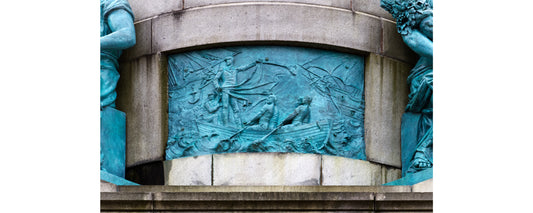For our vacation this week, we’re traveling back to some favorite recent stories, including this life story.
* * *
When I purchased a set of vintage New Haven postcards off eBay, I knew I was cracking a window into the life of the city. I didn’t know I was opening a door into the life of a person.
“Frank” is how he signed the nearly 90 notes he sent between 1909 and 1913. Almost all were addressed to Mrs. W. S. Haigh in Green Lake, Wisconsin—Frank’s mother, clearly, who lived in such a small town that no street address was necessary. Equally apparent was the reason Frank had come to New Haven: to study at Yale.
The finer points of Frank emerged more slowly, over the course of the cards. He might have been—actually, he was—studying a science, and maybe—no, definitely—that science was chemistry. And while he reports taking tests, he also reports grading them, indicating he was a grad student, not an undergrad. He worked in a lab, too, which involved, at one point, “distilling tar all day and for some days past.” A week later, in another postcard: “I am still distilling tar.”
sponsored by
Frank’s prose rarely gets purpler, at least within the space afforded by these postcards, but his life outside the lab sounds reasonably colorful. In September 1910, he writes, “Academic rush was tonight. Freshmen won in the wrestling matches I believe.” In March 1911, he says he “rode
Significant historical figures and moments sneak in. “Heard a good lecture last night by Lyman Abbott,” Frank writes in November 1910. In September 1911, he reports, “Prof. Foote got back today. He is looking fine. Has been in Peru all summer,” where, in fact, a Yale chemistry professor named Harry Ward Foote had “served as the expedition collector and naturalist” for the first academic field investigation of Machu Picchu. And though the date of the postmark isn’t present, there’s little doubt what Frank is referring to when he writes, “That was an awful shipwreck! Suppose you have seen the papers.”
Other connections are internal to the notes themselves. In one of the only postcards not addressed to his mother, Frank wishes one Mr. Benj. Haigh, also in Green Lake, “a Happy 91st Birthday.” A year and one day later, on a postcard sent to his mother, he writes, “This is grandpa’s birthday. Almost a year since he left us.” On another card, likely unsent and meant only for himself, Frank tries out different stylized versions of his signature, perhaps daring to imagine that his signoff might someday be important. The postcard also reveals our protagonist’s full name: Frank Loyal Haigh.
As the postcards approach their chronological end, Frank’s anxieties about finishing his degree and starting his career peek through. March 7, 1912: “Have not heard anything more from possible positions.” April 25, 1912: “Thesis going all right. 43 pages done. About 2/3 finished.” May 16, 1912: “Had my exam this P.M. and am still alive to tell the tale.” Dotting many of the notes Frank sent that school year is the news that there’s “no news,” presumably in reference to his job search. Then, finally, on March 20, 1913, comes the relief of some certainty: “Will write all about plans soon. Will be here again next year.”
The internet can tell us some of what followed. Frank was married to Mabel Frost on August 23, 1913, a little over a year after earning his Ph.D from Yale. In 1916, he joined the faculty of Whitman College in Walla Walla, Washington, as a professor of chemistry. In 1923, a daughter, Helen, was born. In 1934, Frank became Whitman’s Dean of the Division of Basic Sciences (The 1943 Waiilatpu, page 10), and by 1950 (also page 10), he’d ascended to Dean of the Faculty—the Whitman equivalent of provost. In 1964, it appears, he served on the First Congregational Church of Walla Walla’s centennial committee, and the symbology on his gravestone indicates he was a Mason to the end, which came in 1972, at age 86.
Isn’t it amazing, Frankly, where a pile of old New Haven postcards can point you?
Written by Dan Mims.








